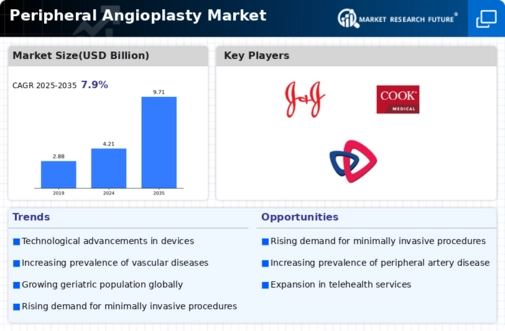Leading market players are putting a lot of money on R&D to expand their product lines, which will drive the peripheral angioplasty market's expansion. Additionally, market players are engaging in a range of calculated initiatives to increase their worldwide presence, with important market developments involving the introduction of new products, contracts, M&A transactions, increased investment, and cooperation with other enterprises. To grow and endure in an increasingly cutthroat and dynamic market, Peripheral Angioplasty industry must provide reasonably priced goods.
Manufacturing locally is one of the primary business techniques used by manufacturers to cut operational costs in the Peripheral Angioplasty industry to help customers and expand the market segment. In recent years, the Peripheral Angioplasty industry has provided some of the biggest benefits to medicine. Major players in the Peripheral Angioplasty market, including Edwards Lifesciences Corporation, B. Braun Melsungen AG, Cook Medical, Johnson & Johnson, Terumo Corporation, Medtronic, Abbott Laboratories, Boston Scientific Corporation, and others, are engaging in research and development activities in an effort to boost market demand.
Boston Scientific Corporation ("BSC") is a worldwide biomedical/biotechnology engineering company that produces medical devices for use in a variety of interventional medical disciplines, such as interventional cardiology and radiology. On June 29, 1979, Boston Scientific was established in Watertown, Massachusetts, forty-four years ago, as a holding company for Medi-Tech, Inc., a medical goods company, with the goal of positioning the latter for expansion into the field of interventional medicine. Itzhak Bentov, a Czech who immigrated to Israel and later the US, was the creator of Medi-Tech.
In January 2021, Boston declared that it will pay up to $1.2 billion to acquire Minneapolis-based Preventice Solutions, Inc. and its suite of mobile heart health solutions.
Abbott Laboratories is a worldwide medical equipment and healthcare firm. In addition to selling medical equipment, diagnostics, branded generic medications, and nutritional goods, the company was established in 1888 by Chicago physician Wallace Calvin Abbott to develop well-known drugs. In 2013, it divided into AbbVie and separated its research-based pharmaceutical division. MitraClip, Glucerna, Ensure, ZonePerfect, FreeStyle Libre, i-STAT, Similac, Pedialyte, and BinaxNOW are among the products made by Abbott. In January 2022, Abbott unveiled Lingo, a set of consumer biowearable sensors that gathers biological data to enhance diet and exercise plans.














